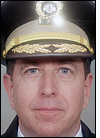Jun 01, 2007North American agencies and volunteer groups that search for people who've wandered away and become lost are using RFID-enabled wristbands and handheld readers—a combination that has drastically reduced the time it can take to find the missing.
In fact, average searches have been reduced to a half-hour or less, according to the 43rd Virginia Search and Rescue Group, a nonprofit volunteer group and the first to use the devices, provided by Locator Systems. The group has since distributed them to local public safety authorities through an organization it founded, Project Lifesaver International. The system uses wristbands and readers operating within the very high frequency (VHF) range. VHF allows for a read range of about a mile on the ground, and even greater distances from the air.Headquartered in Chesapeake, Va., Project Lifesaver now has 566 agencies participating in 41 U.S. states and one Canadian province. Those agencies, which include sheriff offices, police and fire departments, are using the system to monitor between 10,000 and 15,000 individuals. In addition to supplying the necessary hardware and software, Project Lifesaver also offers two-day training programs for new users.
In 1999, the Virginia Search and Rescue Group first began seeking technology that could help volunteers search for individuals—primarily Alzheimer's sufferers or those with autism—who had wandered away from their caregivers. In such cases, search-and-rescue personnel would sweep the area by walking or driving around the missing person's home. The average missing person walks at a speed of about 4 miles per hour, and the search could take hours or more, says Col. Tommy Carter, Project Lifesaver International's chief of training.
Such search efforts can be vastly expedited with the use of RFID-enabled wristbands and handheld interrogators. Each wristband can also be worn on the ankle or attached to a shoe, and comes with an active RFID chip and antenna, as well as a battery with a one-month lifespan. The chip is set to constantly transmit its unique ID at a specific frequency within the range of 216 to 217 MHz. Participating agencies, mostly county sheriff offices, provide the active RFID bracelets to participating members.
The specific transmission frequency the tag uses varies among wristbands, says Locator Systems CEO Jim McIntosh, to prevent the handheld from picking up irrelevant signals if multiple wristbands are beaconing in the same geographic area during a search. If, however, several wristbands beacon at the same frequency, the ID number helps differentiate the identities of those wearing the wristbands.
When someone is reported missing, the search agency dispatches personnel, either on foot or in cars, with handheld RFID readers. The searchers set the interrogators to the appropriate frequency for the missing person's wristband and begin combing the area. "The [reader] chirps, and the ID number shows up on the screen," Carter explains, when the device comes within range of the wristband (about 1 mile). After confirming the ID number, rescue personnel begin following the signal, which grows stronger as they approach the individual, indicated by a louder chirp. According to Carter, the first rescue mission to use the system—in Chesapeake County, in 1999—took six minutes to find the individual.
Participating Project Lifesaver agencies can make the wristbands available free to the individuals wearing them, or they can charge up to $250 apiece (or a fee of $25 per month). Participating agency personnel visit each individual monthly to replace batteries and confirm the wristbands are functioning properly. They also retrieve old batteries and provide an inspection sheet updating the agency as to each user's status, including a health update and the likelihood of that person wandering. "That's good community relations," Carter says, adding that the system has drawn interest from other countries as well, including New Zealand, Spain and India.
Late last month, Locator Systems announced it was updating the tracking system to include GPS and cell phone technology options, which could further reduce the time needed to locate missing persons. With the updated product offering, the company will make available an alternative wristband that incorporates an RFID tag, a GPS tracking device and a cellular radio. A participating agency, alerted that a wristband wearer is missing, can log into a Web-based system hosted by Locator Systems, enabling it to search for and locate the individual on a map of the area (the GPS device cannot locate a missing individual indoors, however). The GPS device allows personnel to pinpoint the wearer's location, which the cellular radio transmits to the server. The RFID tag provides a redundant tracking mechanism, McIntosh says, if GPS data is unavailable.
Additionally, the GPS-cellular version will enable alert options based on geofencing—a virtual boundary within a geographical area. This will allow a caregiver to dictate a normal route to be traveled by a particular person wearing a wristband. If the individual strays from that route, the system can alert emergency personnel and the caregiver.
Pricing for the new product version has not yet been determined, McIntosh says, though it will cost somewhat more than the existing RFID-only wristband. He declines to reveal the cost to Project Lifesaver for the wristbands and readers.


